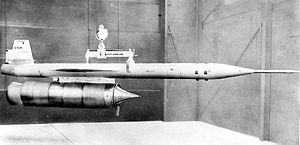Lockheed X-7
| X-7 | |
|---|---|
 |
|
| Role | Experimental aircraft |
| Manufacturer | Lockheed Corporation |
| First flight | April 26, 1951 |
| Retired | 1960 |
| Primary user | United States Air Force |
| Developed into | AQM-60 Kingfisher |
The Lockheed X-7 (dubbed the "Flying Stove Pipe") was an American unmanned test bed of the 1950s for ramjet engines and missile guidance technology. It was the basis for the later Lockheed AQM-60 Kingfisher, a system used to test American air defenses against nuclear missile attack.
Development of the Kingfisher was first initiated in December 1946. The X-7 was called into production by the United States Air Force required the development of an unmanned ramjet test plane with a top speed of at least Mach 3 (2301.1 mph)
Originally the X-7 project was developed under MX-883 and was titled Model L-151, and was designated the PTV-A-1 but received its official title of the X-7 in 1951. Despite its first launch being a failure, after re-development of the original ramjet, following test flights were successful.
The X-7 laid the foundation for the AQM-60 Kingfisher. This was a system developed to protect United States soil from nuclear missile attacks. Being the testbed for a several yearlong projects, the X-7 underwent many structural changes to adapt more closely for its intended purpose. The Kingfisher was put up against three surface to air missiles designed to test the capabilities of the X-7; SAM-A-7/MIM-3 Nike Ajax, SAM-A-25/MIM-14 Nike Hercules, and IM-99/CIM-10 Bomarc were the missiles used in the tests. During the testing of the SAMs, the X-7 out preformed the missiles and a very small number of critical hits were achieved. Due to the pressure and embarrassment put on the military the X-7 project was canned in the mid-1960s.
Besides the surface to air missile tests, the X-7 project was also used to test communication equipment for acceleration testing, testing aerodynamics, booster propellants, thermodynamics, and parachutes.
Performance: Compared to other experimental aircraft the X-7 much more efficiently maximized its speed with its range. While most experimental aircraft topped off at around 926 knots, the X-7 maximized its speed and range to be more than 200 percent more efficient than the rest. Comparing the same speeds to that of Military aircraft the X-7 held a 633 percent margin.
Construction: The X-7 was constructed from steel unlike its predecessors such as the A-12 and YF-10 which used titanium. These planes had wings constructed from stainless steel but had a fuselage crafted from nickel alloy. The use of steel was due to the heat caused by the fuel that the X-7 burnt. It ran on Hi Cal-3 zip fuel, which had a heating value of 26,500 Btu/lb.
Lunch Method: The launch method of the X-7 was an at speed release from the underside of either a B-29 or B-50 carrier plane. (The B-29 was earlier used for bombing runs on Japan during WWII and as transport and cargo carrier, but was later retrofitted to carry the X-7 to its flight position.) The jet would then take over and build up speed to its top speed of 1000 miles per hour, but was later redesigned to push Mach 4.3 or 2800 miles per hour.
...
Wikipedia
